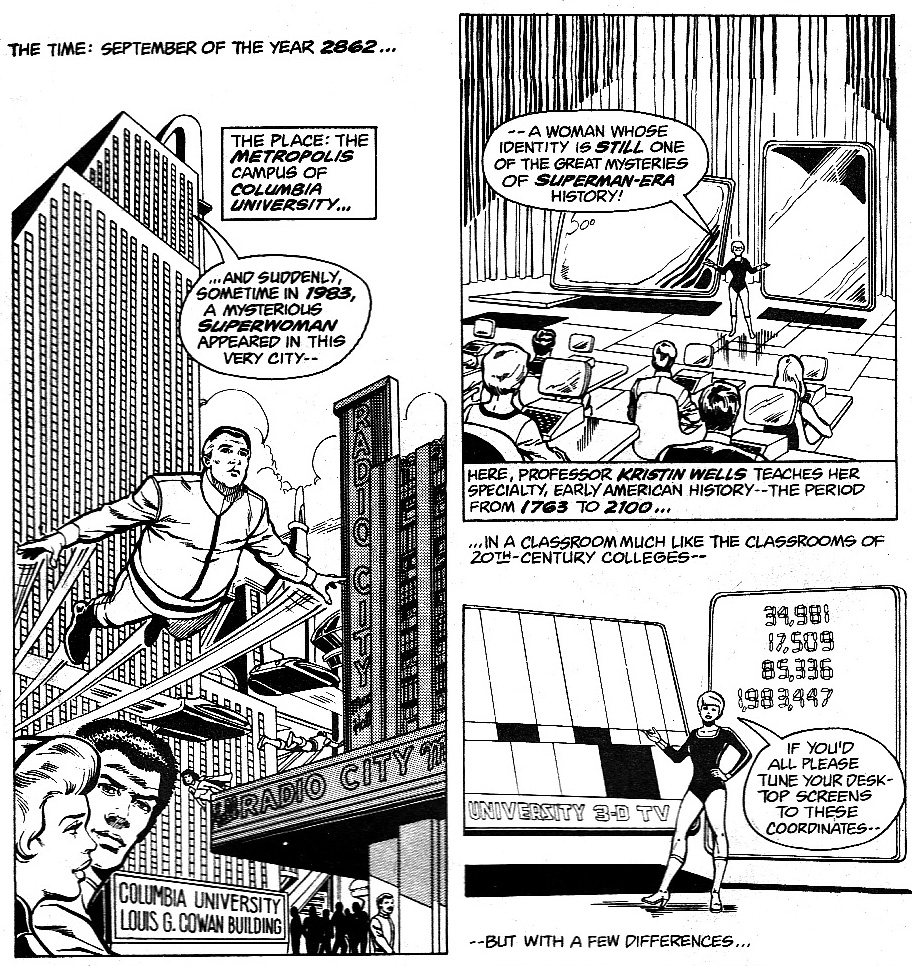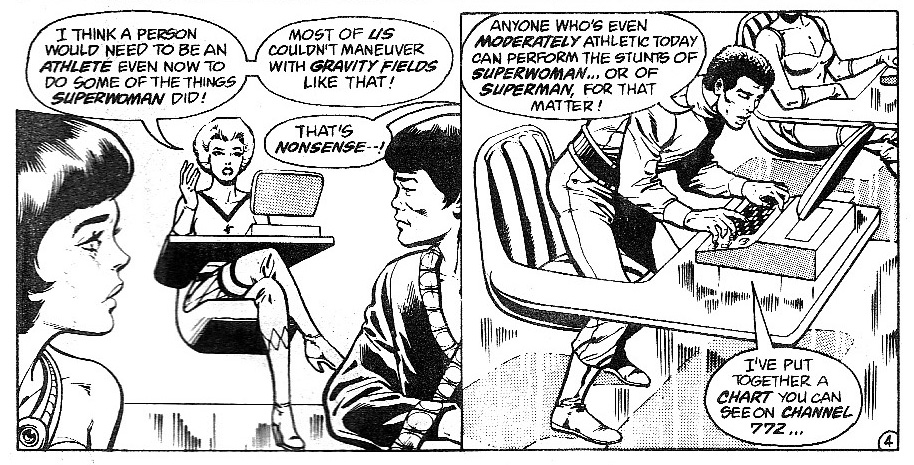I thought that as, apparently, it is the last day of term today for university students, that I would share a picture or two I’ve found from a 1984 issue of Superman, which depicted the Columbia University classroom of 2862. Just a mere 850 years in the future.

Perhaps time travel is working faster than we thought. The computers the students were using look a little like a cross between an early Sinclair and an iPad, if that is possible, while the lecturer looks like a hot babe in a leotard. Fortunately none of my university tutors never wore leotards in class, as that may have freaked the fish right out.

Luckily, the students back then / forward then, are hip and groovy, and the schools come with floating furniture, and versions of giant iPads that the class can communicate with the teacher on…

Roll on the future!
(but I’m not going to wait 850 years….)





One of the great mysteries of history? Surely that mystery would be How Come they managed to so accurately foretell the shape of the iPad’s flat screen, but not the function ie deleting the keyboard? People of all ages can fly, and yet they haven’t invented the Matrix that you can just jack off / into? Radio City Music Hall is still intact, despite the 900 years since it was built? Clearly no leaky building syndrome in New York!
>Radio City Music Hall is still intact, despite the 900 years since it was built?
What does a city like New York do with its skyscrapers in the future? Presumably someone will have to demolish the Empire State Building at some future date and it’ll be a pretty big task. How long are these buildings likely to last, assuming regular refurbishment? Is it possible that they’ll be around in 1000 years, like European cathedrals are today?
that’s a really good question, to which I have no idea. Presumably however: as long as the steel frame in a building is kept in good nick, and free from rust, there is no reason to suppose any real long-term effects, and it could be around for years.
Concrete, on the other hand, is by nature a material with a limited life span. I should say “reinforced concrete” really, as it is the steel reinforcement that causes the problems for the concrete in the long term. Judging by the number of buildings in Wellington with concrete cancer, anything built with an inadequate concrete cover will suffer water ingress and corrode. The Pantheon in Rome is 2000 odd years old, and has no corrosion issues as it has no steel reinforcing. Yet various towers around Wellington built in the 1950s, will face demolition from steel corrosion causing irreparable harm to their concrete – within the next 20-30 years.
Empire State Building, of course, has a steel frame and has just been refurbished to LEED Gold Star status. It’ll be around for years yet. Something like the Majestic Centre in Wellington, on the other hand….
I’m not sure I’d want to save the Majestic Centre long term. It’s a pleasant enough building (I like the lights on sticks), but I’d be quite happy if it were replaced with something better in 30 years time. I don’t see demolition as being a super hard project.
On the other hand, I hope that people hundreds of years in the future will look at the best of the New York skyscrapers and marvel that they were built in the 1930s. Of course some future people will think that 1930s people couldn’t possibly build things that large and cool, and will conclude that aliens must have built them.
As a PS to my last comment… I’m spending a lot of work time at the refurbished Telecom building on Willis St. I think it is absolutely superb. The inside is really funky, I like the sloping glass on the Willis St frontage, I like sitting in meeting rooms with floor-to-ceiling glass looking out at the street, and I like the way it presents itself as I walk down Chews Lane.
It’ll be even better once the council have finished digging up Willis St. At the moment crossing from one side to the other is like trying to cross No Man’s Land in 1916.
Lucky you davidp the Telecom building looks nice.
I’m currently in Plimmer Towers, I’ve been in the building since feb this year. It’s quite a nice building and I think it has been refurbished because In a few older pictures of the Wellington skyline the building is some horrible skin colour, the interior looks recentlyish redone. One of the workers doing over a floor reckons the building has a dodgy kink in it about half way up :/ but both the baldwin intelluctual property building and the eds building, which I see out the window look like they’re being held up by twigs!
I’m not based in the Telecom building, Eastbourne. I just spend a lot of time there with meetings, and it is always a joy to watch the glass wall elevators and all the exposed piping and wiring.
I suspect the glass wall elevators are so that you can check there isn’t an assasin riding on the roof of your elevator before you board. I’ve seen a lot of films and it is distressing how often criminals drop through the roof of an elevator and terrorise the people inside.
My own office is on Lambton Quay in a circa 1920s-vintage building. It’s much less cool, but on the other hand I have an office of my own and a window that opens on to the Quay. It lets in warm air and sun during the summer, and I can always stick my head out to figure out what is causing commotion on the street.
I have a strong affection for early C20th office buildings with their mysterious corridors and plethora of independent tenancies. Seems to me that one of the worst effects of the changeover to (sub-) Miesian office blocks with their open floor-plates is the near impossibility of populating them with small businesses like dentists, tailors, accountants and watch repairers, not to mention all those hopeful one-room startups. Without affordable 20m2 work spaces those people have to head for the fringes along with their clients. Meanwhile the unsuitable buildings never get a more complex second life as urban coral reefs. Instead they drop off the bottom of the commercial rental market until they either get expensively refurbished or pulled down.
I have noticed that whole floors of 1970s/80s mini-towers in Boulcott St have been sold recently for less than $300,000 – about the same as a 60m2 shoebox apartment a block or two away.
Starkive and Davidp – yes, you are right indeed that the different size of modern buildings makes those old-style offices unavailable. The sort of film noir space where Philip Marlow has his office space with a door marked “Private Eye”. Everything is in black and white. The corridor is empty. The door is open. A curl of smoke from a recently lit cigarette curls lazily from the ashtray. The body of a woman lies broken on the floor, hemline dangerously askew… You know the score.
I dunno. Did that ever really exist in Wellington like that? Or is that all just my imagination? Does it exist like that anywhere in Wellington any more?
My favourite survivor of that era is the former DIC building, now the Harbour City Tower. Long, snaky corridors with salt-glaze tiles and ripple-glass doors. Thick carpet runners. Ponderous lifts. Masonry dividing walls between tenants… Doubtless full of private eyes and orthopedic shoe makers.
Indeed, the DIC comes to my mind as well. I went to see a lawyer there – it felt it was straight out of Dickens, if not a Raymond Chandler novel. Leather topped desk. Fountain pen. Name plate on the wainscot outside, I’m pretty sure it was in gold lettering. Olllllldd schoool. Kind of comforting.
Eastbourne you are correct, the Plimmer Towers used to be a foul mid-ochre bay vomit colour
Now, how many on this blog knew that DIC stood for Direct Importing Company?
correction – should read “baby-vomit”
Only the tops floors of the harbour city tower are still in the original config – the bottom three floors of office are occupied by contact energy, who create all that electricty in open-plan nirvana……………